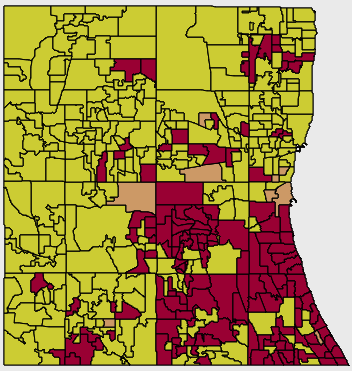As was expected, Donald Trump won the Illinois primary yesterday—and won handily: 38 percent to Ted Cruz at 30 percent, John Kasich at 20 percent, and now-departed Marco Rubio with nine percent.
Also as expected, Trump did well almost everywhere. He won Cook County with 40.7 percent of the vote, 16 points ahead of John Kasich. He won all the collar counties. He won all the counties in far downstate Illinois. He won Illinois's wealthiest county (Lake) and its poorest (Alexander). He did well everywhere except central Illinois, where Ted Cruz won 19 counties, and the Rockford area, where Cruz won three.
And Trump continued to confound expectations. The conventional wisdom is that Trump's base is economically disaffected, poorly educated whites, and there are good correlations to back that up. Yet Trump won Lake County, the wealthiest county by per capita income, and second wealthiest by median household income and median family income.
Lake County isn't all rich people, obviously, and John Kasich tended to do well in the wealthier enclaves of the county. Here's a not-great map of the results from the Lake County clerk; Kasich won the precincts in maroon, Trump in avocado, and beige is a tie.

Kasich is strong towards the southeast portion of the county near the lake, around Highland Park, Deerfield, and Lake Forest. Trump is stronger to the less affluent places to the north, like Waukegan, Antioch, and Lakemoor.
It parallels what my colleague Luke Seemann found in the city itself, where Kasich did best in affluent areas of the North Side near the lake, and Trump did best in the more middle/upper-middle class, lower-density neighborhoods on the city's fringes. (Trump's best precinct was in Mount Greenwood, and he picked up the most votes in the 19th Ward, winning 2,500 with 52 percent of the vote. That ward crosses Beverly and Mount Greenwood, which have the second- and fifth-highest median household incomes of the city's community areas.)
But Donald Trump did respectably even in some of Lake County's richest towns. I drilled down to the results of the precincts that encompass three of them, among the wealthiest in the state: Lake Forest (per capita income $77,000, fifth-highest); North Barrington ($81,000, fourth highest); and Riverwoods ($68,000, 11th-highest). All three have median household incomes above $150,000; Riverwoods has the highest percentage of the population below the poverty line, at 3.2 percent. (Totals don't include a handful of votes for candidates who dropped out prior to the primary.)
Lake Forest
| Trump | Kasich | Cruz | Rubio |
|---|---|---|---|
| 1,344 | 1,886 | 803 | 506 |
| 29.6% | 41.6% | 17.7% | 11.2% |
North Barrington
| Trump | Kasich | Cruz | Rubio |
|---|---|---|---|
| 390 | 327 | 260 | 141 |
| 34.9% | 29.2% | 23.3% | 12.6% |
Riverwoods
| Trump | Kasich | Cruz | Rubio |
|---|---|---|---|
| 261 | 176 | 95 | 233 |
| 34.1% | 30.5% | 23.0% | 12.4% |
Trump lost Lake Forest, but he held his own, just as he did in Chicago's Near North Side wards, finishing second to Kasich with between 20-30 percent of the vote. And he won the small but wealthy towns of North Barrington and Riverwoods to the west.
On the other side of the invisible hand, consider Winnebago County. It had the biggest decline in median household income from 2000-2014, according to this convenient Reboot Illinois list from a few days ago. It fell 22 percent, from $61,000 to $48,000. Its biggest city is Rockford, which has been crippled by the loss of manufacturing jobs.
Prime ground for Donald Trump, right? No, he lost by five points to Ted Cruz.
Trump won No. 2 on the list, Knox County, but by just two percent. He did better in Boone County, just east of Winnebago County, with a six-point victory, but lost Stephenson County, to its west, which is seventh on the list and another hard-hit manufacturing area.
Peoria and McLean county in central Illinois were near the bottom, across the 339 largest counties in America, for job losses in 2014—tied for 336th. Late last year brought more bad news when Caterpillar, headquartered in Peoria, announced huge job cuts. And Ted Cruz beat Trump in Peoria County by 11 points and in McLean by 14. He beat Trump in Tazewell and Woodford County, the two counties in between Peoria and McLean, by double digits.
Illinois a diverse state, one that arguably represents the electorate better than any in the country. That Trump won is a big deal, and he won with votes from across diverse areas of the state—while struggling in areas that might challenge assumptions about what socioeconomic phenomena have driven his surprising success. In one of the strangest presidential races in the country's history, there's still much to learn about its most unpredictable figure.


